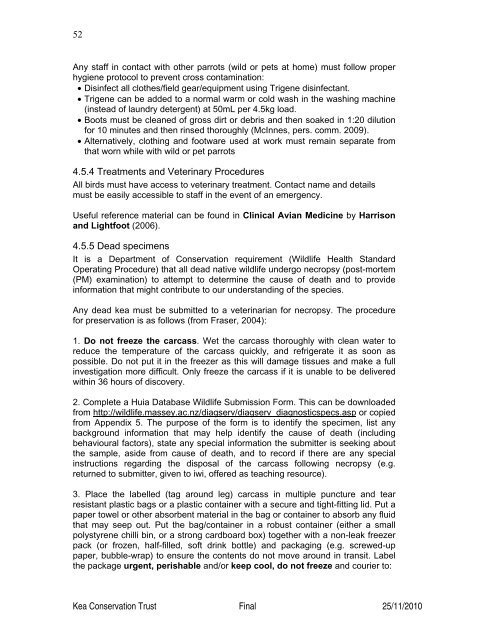(Nestor notabilis) Husbandry Manual - Kea Conservation Trust
(Nestor notabilis) Husbandry Manual - Kea Conservation Trust
(Nestor notabilis) Husbandry Manual - Kea Conservation Trust
Create successful ePaper yourself
Turn your PDF publications into a flip-book with our unique Google optimized e-Paper software.
52<br />
Any staff in contact with other parrots (wild or pets at home) must follow proper<br />
hygiene protocol to prevent cross contamination:<br />
• Disinfect all clothes/field gear/equipment using Trigene disinfectant.<br />
• Trigene can be added to a normal warm or cold wash in the washing machine<br />
(instead of laundry detergent) at 50mL per 4.5kg load.<br />
• Boots must be cleaned of gross dirt or debris and then soaked in 1:20 dilution<br />
for 10 minutes and then rinsed thoroughly (McInnes, pers. comm. 2009).<br />
• Alternatively, clothing and footware used at work must remain separate from<br />
that worn while with wild or pet parrots<br />
4.5.4 Treatments and Veterinary Procedures<br />
All birds must have access to veterinary treatment. Contact name and details<br />
must be easily accessible to staff in the event of an emergency.<br />
Useful reference material can be found in Clinical Avian Medicine by Harrison<br />
and Lightfoot (2006).<br />
4.5.5 Dead specimens<br />
It is a Department of <strong>Conservation</strong> requirement (Wildlife Health Standard<br />
Operating Procedure) that all dead native wildlife undergo necropsy (post-mortem<br />
(PM) examination) to attempt to determine the cause of death and to provide<br />
information that might contribute to our understanding of the species.<br />
Any dead kea must be submitted to a veterinarian for necropsy. The procedure<br />
for preservation is as follows (from Fraser, 2004):<br />
1. Do not freeze the carcass. Wet the carcass thoroughly with clean water to<br />
reduce the temperature of the carcass quickly, and refrigerate it as soon as<br />
possible. Do not put it in the freezer as this will damage tissues and make a full<br />
investigation more difficult. Only freeze the carcass if it is unable to be delivered<br />
within 36 hours of discovery.<br />
2. Complete a Huia Database Wildlife Submission Form. This can be downloaded<br />
from http://wildlife.massey.ac.nz/diagserv/diagserv_diagnosticspecs.asp or copied<br />
from Appendix 5. The purpose of the form is to identify the specimen, list any<br />
background information that may help identify the cause of death (including<br />
behavioural factors), state any special information the submitter is seeking about<br />
the sample, aside from cause of death, and to record if there are any special<br />
instructions regarding the disposal of the carcass following necropsy (e.g.<br />
returned to submitter, given to iwi, offered as teaching resource).<br />
3. Place the labelled (tag around leg) carcass in multiple puncture and tear<br />
resistant plastic bags or a plastic container with a secure and tight-fitting lid. Put a<br />
paper towel or other absorbent material in the bag or container to absorb any fluid<br />
that may seep out. Put the bag/container in a robust container (either a small<br />
polystyrene chilli bin, or a strong cardboard box) together with a non-leak freezer<br />
pack (or frozen, half-filled, soft drink bottle) and packaging (e.g. screwed-up<br />
paper, bubble-wrap) to ensure the contents do not move around in transit. Label<br />
the package urgent, perishable and/or keep cool, do not freeze and courier to:<br />
<strong>Kea</strong> <strong>Conservation</strong> <strong>Trust</strong> Final 25/11/2010












